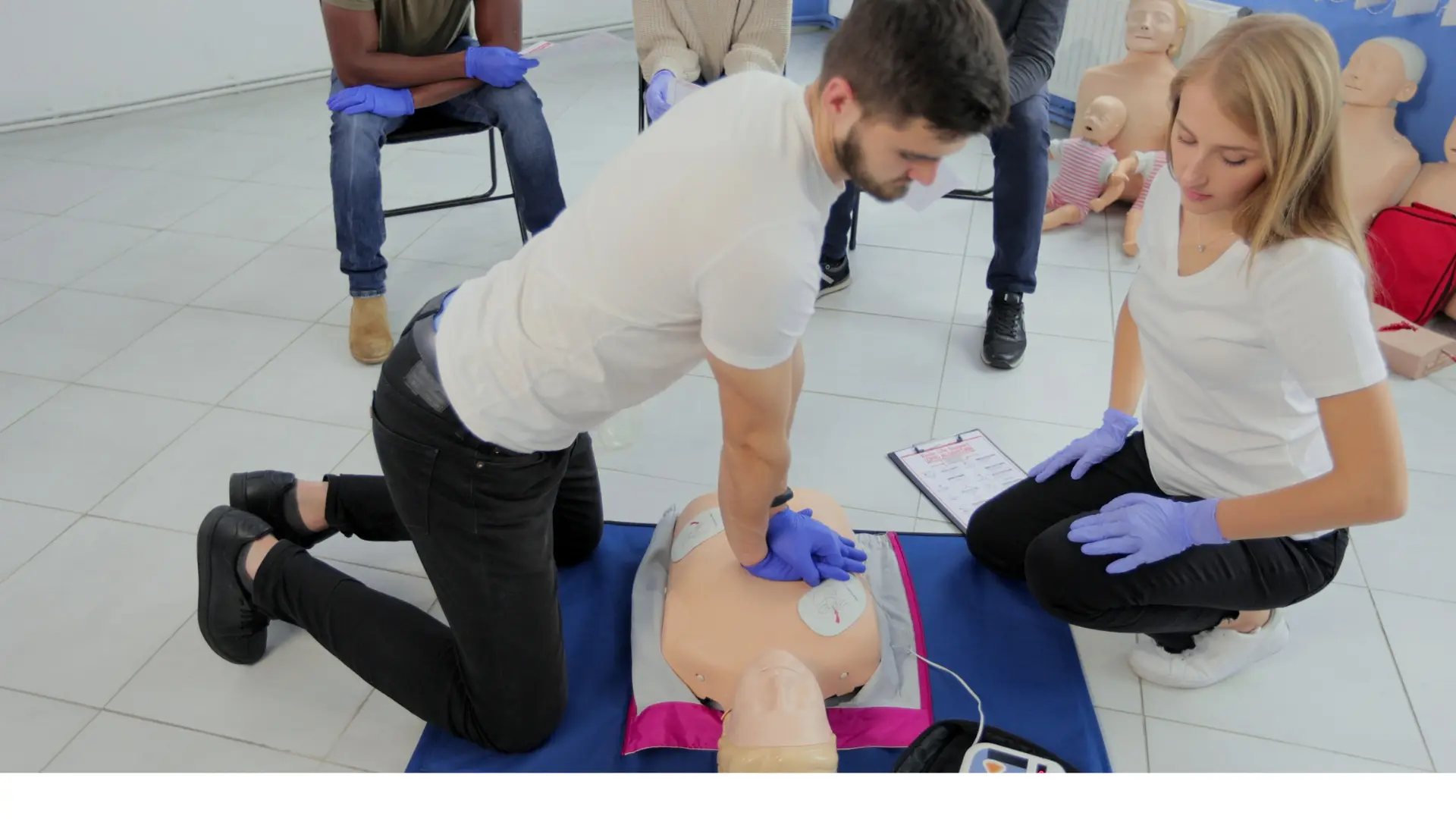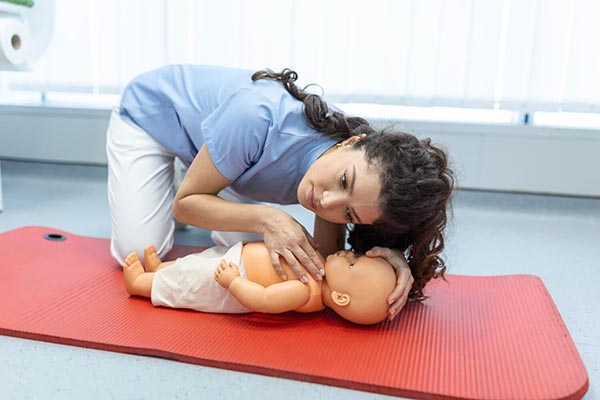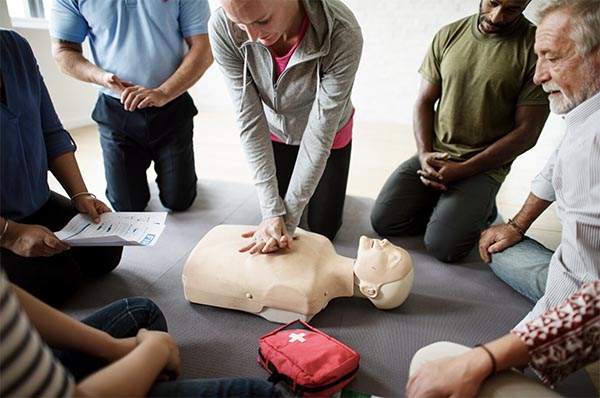
Cardiopulmonary Resuscitation (CPR) is a powerful, life-saving skill. Yet, many people mistakenly believe it’s a single, unchanging set of actions.
The truth is, CPR is not one-size-fits-all.
The way you perform CPR on a newborn is vastly different from how you would help a senior citizen. The challenges a teacher faces in a classroom emergency are unique compared to those a hiker encounters on a remote trail. Understanding these nuances is the key to transforming your knowledge from theoretical to truly effective.
This guide explores how to adapt life-saving CPR techniques for specific groups and high-stakes situations. We will cover the critical modifications needed for parents, teachers, childcare professionals, seniors, hikers, and of course, infants.
CPR for Infants: A Guide for Parents
For a parent, the thought of their infant needing CPR is terrifying. But being prepared is your greatest strength. Infant CPR is one of the most specialized forms of resuscitation.
The primary reason is that sudden cardiac arrest in infants is rarely caused by a primary heart problem, as it often is in adults. Instead, it’s typically the result of a respiratory issue, like choking, suffocation, or a severe asthma attack.

Key Differences in Infant CPR (Under 1 Year Old)
- Check for Responsiveness: Gently tap the bottom of the infant’s foot and shout their name. Do not shake an infant.
- Check for Breathing: Look for the rise and fall of the chest.
- Call 911: If you are alone, perform CPR for 2 minutes before calling 911. If someone else is present, have them call immediately.
- Pulse Check: Check for a pulse on the inside of the upper arm (brachial artery), not the neck.
- Compressions: Use two fingers (index and middle) in the center of the chest, just below the nipple line.
- Compression Depth: Press down about 1.5 inches. This is much shallower than for an adult.
- Compression Rate: Maintain the same rate as adult CPR: 100 to 120 compressions per minute.
- Rescue Breaths: Gently tilt the head back. Cover the infant’s mouth and nose with your mouth and give two gentle puffs of air, each lasting about one second. You should see the chest rise. Do not use the full force of your lungs.
Every parent and caregiver should be certified in infant CPR. The confidence and muscle memory you gain from hands-on training are invaluable in a high-stress emergency.
CPR for Teachers & Child Care Professionals
Teachers and child care professionals are on the front lines of child safety. For you, CPR is not just a good skill to have, it’s a core professional responsibility. In many states, certification is a legal requirement for licensing.
Your challenge is twofold: performing CPR correctly on a child and managing the entire scene.
Scene Management in a School or Daycare
Imagine an emergency unfolds in a classroom full of children. Your training must prepare you for more than just the mechanics of CPR.
- Stay Calm: Your calm demeanor will help keep the other children from panicking.
- Activate Your Emergency Plan: Immediately send a specific student or another adult to call 911 and alert the school administration or front office. Use clear, direct language: “You, go to the office right now and tell them we have a medical emergency in Room 101. Run!”
- Isolate the Area: If possible, have another adult move the other children to a different location to protect their emotional well-being and clear the space for EMS to arrive.
- Begin CPR: Once help is on the way, you can focus on providing care to the victim. Child CPR (ages 1 to puberty) is similar to adult CPR but with a few modifications, such as using one or two hands for compressions depending on the child’s size.
Being prepared means knowing your school’s emergency action plan inside and out. It means practicing not just CPR, but the entire sequence of events that an emergency would trigger.
CPR Considerations for Seniors
Seniors represent a unique group in the world of CPR. They are statistically more likely to be victims of sudden cardiac arrest, but they can also be empowered rescuers.
When a Senior is the Victim
Performing CPR on an older adult requires a few special considerations.
- Pre-Existing Conditions: The victim may have conditions like osteoporosis (brittle bones). While you may hear a cracking sound during compressions, this is not a reason to stop. A broken rib is survivable; cardiac arrest is not.
- Pacemakers/ICDs: You may see a hard lump under the skin of the chest or abdomen. This is likely a pacemaker or an Implantable Cardioverter-Defibrillator (ICD). Do not place AED pads directly over the device. Adjust pad placement as needed, but continue with CPR.
- Dentures: If dentures are secure, leave them in place to create a better seal for rescue breaths. If they are loose and may block the airway, remove them.
When a Senior is the Rescuer
Many older adults worry they aren’t strong enough to perform effective CPR. While the physical demand is real, there are options.
- Hands-Only CPR: The American Heart Association endorses Hands-Only CPR for bystanders who are unwilling or unable to perform rescue breaths. It involves pushing hard and fast in the center of the chest at a rate of 100-120 compressions per minute. It has been shown to be highly effective and can be easier for rescuers with physical limitations.
- Good Samaritan Laws: These laws exist in all 50 states to protect people who provide reasonable emergency aid from lawsuits. This should give all rescuers, including seniors, the confidence to act without fear.
CPR for Hikers and in Remote Situations
An emergency in the wilderness is profoundly different from one in an urban setting. For hikers, boaters, and anyone enjoying the outdoors, CPR knowledge is critical because help is often far away.
The biggest challenge is time.
Professional medical help might be hours away, not minutes. This means you may have to perform CPR for a much longer duration than usual.

Key Considerations for Wilderness CPR
- Scene Safety is Paramount: Before you do anything, ensure the scene is safe. You cannot help someone if you become a victim yourself. Look for unstable ground, rockfall hazards, or dangerous wildlife. Move the victim to a safer, flatter spot if possible.
- Call for Help Immediately (If Possible): If you have cell service or a satellite communication device (like a Garmin inReach or SPOT), send for help immediately. Provide your exact coordinates, the nature of the emergency, and the number of people in your party.
- Teamwork and Endurance: Performing CPR is exhausting. If you have a hiking partner, you must work as a team. Switch who is performing compressions every 2 minutes (or every 5 cycles of 30 compressions and 2 breaths) to prevent fatigue. Tired compressions are ineffective compressions.
- Focus on Compressions: In a prolonged rescue scenario, high-quality chest compressions are the most critical element. If you are alone and exhausted, prioritize continuous compressions over rescue breaths.
- Hypothermia Concerns: In cold environments, a victim’s core temperature can drop dangerously low. Protect them from the elements as much as possible with blankets, extra clothing, or a space blanket, both during and after CPR.
Wilderness First Aid and CPR courses are specifically designed for these scenarios and are highly recommended for anyone who spends time on the trail.
The Unifying Factor: Confidence Through Training
Whether you are a new parent, a dedicated teacher, an active senior, or an avid outdoorsperson, the core message is the same: CPR knowledge must be tailored to your life.
Reading an article is a great first step, but it is not a substitute for professional, hands-on training. A certification class provides the muscle memory, practical experience with mannequins, and the confidence to act decisively when seconds count.
You will learn to assess a scene, to perform compressions at the right depth and rate, to use an AED, and to handle the specific challenges of your environment or the person you are caring for.
An emergency won’t wait for you to feel ready. Your preparation today can make all the difference tomorrow.
Don’t wait. Find a class that fits your needs and get certified. Contact CPR Classes Near Me today to take the most important step in being prepared.
Frequently Asked Questions (FAQ)
Q: What is the main difference between adult and child CPR?
A: The main differences lie in the technique and the initial action. For a child (age 1 to puberty), you can often use one hand for compressions instead of two, and the compression depth is about 2 inches. For an infant, you use only two fingers to a depth of 1.5 inches. Additionally, if you are alone and witness the collapse of an adult, you call 911 first. If you are alone with an unresponsive child or infant, you perform 2 minutes of CPR before calling 911, because the cause is more likely to be respiratory.
Q: Can I really hurt someone by doing CPR? What about pacemakers?
A: A common fear is causing harm, such as breaking a rib. While this can happen, a broken rib is treatable, whereas sudden cardiac arrest is fatal without intervention. Always perform CPR on someone who is unresponsive and not breathing normally. Regarding pacemakers, you may see a hard lump under the skin. Simply avoid placing the AED pads directly on top of the device. Continue CPR and use the AED as instructed; it will not harm the victim.
Q: Is Hands-Only CPR actually effective?
A: Yes, Hands-Only CPR is very effective. The American Heart Association recommends it for bystanders who are not trained in conventional CPR or are hesitant or unable to provide rescue breaths. Continuous, high-quality chest compressions keep oxygenated blood flowing to the brain and other vital organs until professional help arrives. For adults and teens, Hands-Only CPR has been shown to be as effective as conventional CPR in many cases.
Q: How do I perform CPR on an infant?
A: Infant CPR is for babies under 1 year old. Check for responsiveness by tapping the bottom of their foot. If unresponsive, use two fingers in the center of their chest to give 30 compressions at a rate of 100-120 per minute, pressing down about 1.5 inches. Then, give two gentle puffs of air, covering their mouth and nose with your mouth. Repeat this cycle. If you are alone, do this for 2 minutes before calling 911.
Q: Why is CPR training so important for hikers?
A: CPR training is crucial for hikers due to the remote nature of their activity. Professional medical help (EMS) can take a very long time to arrive on a trail. This means a hiker may need to perform CPR for a prolonged period. Training provides the skills for endurance, teamwork (switching off with a partner), scene safety assessment on uneven terrain, and managing the situation until help can get there.
Q: As a teacher, what are my legal protections if I perform CPR at school?
A: All 50 states have Good Samaritan laws that provide legal protection for individuals who act in good faith to provide emergency medical care to a victim. As long as you are acting reasonably within the scope of your training, you are generally protected from liability. Many schools also have specific policies and insurance that cover staff in these situations.
{ “@context”: “https://schema.org”, “@type”: “FAQPage”, “mainEntity”: [{ “@type”: “Question”, “name”: “What is the main difference between adult and child CPR?”, “acceptedAnswer”: { “@type”: “Answer”, “text”: “The main differences lie in the technique and the initial action. For a child (age 1 to puberty), you can often use one hand for compressions instead of two, and the compression depth is about 2 inches. For an infant, you use only two fingers to a depth of 1.5 inches. Additionally, if you are alone and witness the collapse of an adult, you call 911 first. If you are alone with an unresponsive child or infant, you perform 2 minutes of CPR *before* calling 911, because the cause is more likely to be respiratory.” } },{ “@type”: “Question”, “name”: “Can I really hurt someone by doing CPR? What about pacemakers?”, “acceptedAnswer”: { “@type”: “Answer”, “text”: “A common fear is causing harm, such as breaking a rib. While this can happen, a broken rib is treatable, whereas sudden cardiac arrest is fatal without intervention. Always perform CPR on someone who is unresponsive and not breathing normally. Regarding pacemakers, you may see a hard lump under the skin. Simply avoid placing the AED pads directly on top of the device. Continue CPR and use the AED as instructed; it will not harm the victim.” } },{ “@type”: “Question”, “name”: “Is Hands-Only CPR actually effective?”, “acceptedAnswer”: { “@type”: “Answer”, “text”: “Yes, Hands-Only CPR is very effective. The American Heart Association recommends it for bystanders who are not trained in conventional CPR or are hesitant or unable to provide rescue breaths. Continuous, high-quality chest compressions keep oxygenated blood flowing to the brain and other vital organs until professional help arrives. For adults and teens, Hands-Only CPR has been shown to be as effective as conventional CPR in many cases.” } },{ “@type”: “Question”, “name”: “How do I perform CPR on an infant?”, “acceptedAnswer”: { “@type”: “Answer”, “text”: “Infant CPR is for babies under 1 year old. Check for responsiveness by tapping the bottom of their foot. If unresponsive, use two fingers in the center of their chest to give 30 compressions at a rate of 100-120 per minute, pressing down about 1.5 inches. Then, give two gentle puffs of air, covering their mouth and nose with your mouth. Repeat this cycle. If you are alone, do this for 2 minutes before calling 911.” } },{ “@type”: “Question”, “name”: “Why is CPR training so important for hikers?”, “acceptedAnswer”: { “@type”: “Answer”, “text”: “CPR training is crucial for hikers due to the remote nature of their activity. Professional medical help (EMS) can take a very long time to arrive on a trail. This means a hiker may need to perform CPR for a prolonged period. Training provides the skills for endurance, teamwork (switching off with a partner), scene safety assessment on uneven terrain, and managing the situation until help can get there.” } },{ “@type”: “Question”, “name”: “As a teacher, what are my legal protections if I perform CPR at school?”, “acceptedAnswer”: { “@type”: “Answer”, “text”: “All 50 states have Good Samaritan laws that provide legal protection for individuals who act in good faith to provide emergency medical care to a victim. As long as you are acting reasonably within the scope of your training, you are generally protected from liability. Many schools also have specific policies and insurance that cover staff in these situations.” } }] }
Leave a Reply